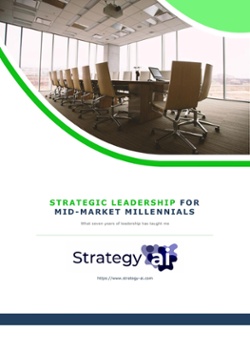In the third part of this series of articles I took a deep dive into how we approached and presented the situation back to the leadership team and how the business responded. This article goes into some details of the changes we made and how we implemented those changes. This whole series is also available as a download.
Our path to better, modern leadership
Finally, the leadership team had more than a gut feeling of what was holding them back. They had hard, empirical facts to highlight their issues. They had the training, skills and experience in-house to solve this, they just hadn't applied it at the right place and time. They'd done it right once a year during that one week of planning, and let the remaining 51 weeks of the year just slip, by not implementing this any further within the business, the managers or team leads.
Our first path was manual
The leadership team decided to start embedding the new workshop into our annual cycle, as a once a quarter retrospective. Over the next few quarters, we successfully ran our new strategy focused retrospective workshop; each time picking up, earlier and earlier, our misalignment issues and saving our bacon, so to speak, on more than one occasion. As a pleasant side-affect, we found that all the team leads involved started to live and breathe the strategy, resonating with it and certainly remembering the deeper intent and finer aspects, than we'd ever seen before. This was a simple and yet powerful by-product by more regular interaction with the strategy rather than just the projects.
After a few of these workshops were conducted across broader aspects of the business, we subsequently found an even bigger, deep issue… while some projects delivered within budget and on-time, these strategic projects failed entirely to deliver meaningful value when we looked at the business drivers.
This was most prevalent with work that required or involved third parties. We identified these projects delivered outcomes that matched perfectly to what we outlined in the projects; thus, we couldn’t fault the third parties, however they failed their ultimate objectives because we asked for the wrong thing.
One such example was a strategic project to integrate with salesforce to extract reporting data for the mining industry. Our customer surveys highlighted the mining sector exclusively uses salesforce. This was project was delivered by an external integration specialist, however when our customers got first use, it had too many unused reports and lacked data they wanted. It transpired that the common reports in salesforce weren’t relevant to the mining industry – thus a lot of expense for zero return, and the data they really wanted was only available in a raw format within salesforce, not as a report.
The budget for the deliverable doubled or tripled in the end, for two key reasons
- we’d wasted far too much time extracting data that wasn’t going to be used and,
- a second project to turn the raw data into the reports the customer actually wanted standardized and automated rather than the raw data.
This all came about because we’d failed to share the driving business factor to the third party. We’d given them a project and an objective, failing to leverage their expertise to ascertain if there was a better way to deliver a solution for the key driving factor in-favor of delivering a project outcome.

It wasn’t perfect, but it was a start
The decision to do this quarterly was a compromise. We really wanted it to be fully baked into our agile cycles, so we could catch this type of misaligned work, as early as possible. We had improved things to the point where we could pick things up before they were developed or implemented to any great depth, but we were still expending a large amount of resourcing in all the analysis and pre-work done as we had three months between workshops. It was still hurting us, as this could vary from 20% to 50% for some of our work loads. We really wanted that ultimate in inefficiency... to catch this type of work before it began.
We had a lingering problem holding us back... and it wasn't us. The initial work I'd done the year before had highlight one major problem... there really wasn't a tool out there to do this with. We looked again, at the existing strategy tooling and platforms available that could reach down to our managers, team leads and third parties; only finding a pretty consistent focus on portfolio management. This portfolio management focus had nice and neat hierarchies, where each item fitted perfectly inside its parent. A task lived in one project, and that project live in one key driving factor. For what we needed and wanted though, all these existing platforms failed to meet our more fluid, interconnected nature of our strategic and leadership thinking. After all, at the very beginning of all our strategy cycles, we would pick projects that aligned with more than one key driving factor.
More importantly, we also knew our teams used different tools from the leadership team. We had gone to great expense to train, implement and migrate to the tools we were using. We didn’t want to retrain and migrate our business to yet another project/task management platform. For this to work, we needed our strategy inside the tools we had already invested in and the ones our teams we were already using.
The final article in this series covers how to automate better, more modern leadership with fully a digital system.

